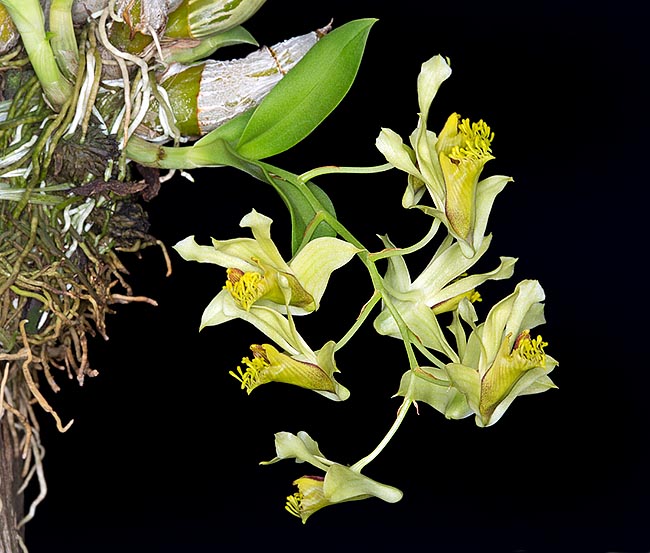Family : Orchidaceae

Text © Pietro Puccio

English translation by Mario Beltramini

Native to Cambodia, Myanmar, Thailand and Vietnam, Dendrobium delacourii is a small epiphytic species with 10-20 cm inflorescences. The unusual tiny flowers measure 1,6-2 cm and last 8-10 weeks © Giuseppe Mazza
The name of the genus is the combination of the Greek substantives “δένδρον” (dendron) = tree and “βίος” (bios) = life, with reference to the numerous species of the genus living on the trees; the species is honoured to the French ornithologist and botanist Jean Théodore Delacour (1890-1985) who collected it in Vietnam in the province of Quang Tri.
Common names: ueang dok makham (Thai).
Dendrobium delacourii Guillaumin (1924) is an epiphytic species, rather variable in the dimensions, with yellowish fusiform pseudobulbs, 5-40 cm long, provided for all their length of oblong leaves, 8-15 cm long and 2-3 cm broad, deciduous at the beginning of the winter, of glossy light green colour.
Sub terminal racemose inflorescences from the new growing pseudobulbs, 10-20 cm long, carrying up to 20 fleshy flowers of 1,6-2 cm of diameter. Ovate sepals about 1 cm long of greenish white colour, the lateral sepals, merged at the base of the column, form a sort of short spur (mentum), lanceolate linear petals, 1,2 cm long, of the same colour as the sepals, trilobed, 1,2 cm long and 1 cm broad, labellum, of yellow colour with lateral lobes striated in red and median lobe striated in purple or brown and fringed margin. The flowers emit a slight scent, deemed little pleasant by some.
It reproduces by seed, in vitro, and division, to be done at the vegetative restart, with each section provided of at least 3-4 pseudobulbs.
Miniature orchid with long lasting, 8-10 weeks, flowers, which distinguish for the fringed labellum, requires high luminosity, also direct sun in winter, medium-high temperatures in summer, cooler in winter, with minimum ones not less than 15 °C, and high humidity, 60-80%, with good and constant ventilation. The waterings during the vegetative period, from spring to early autumn, must be regular and abundant, but leaving to dry up before giving water again, gradually more spaced in winter until the vegetative restart. For the waterings and the nebulisations is to be used rain water, from reverse osmosis or demineralised; the fertilizations, properly distributed and alternated, in way to avoid salts accumulation at the roots, are to be done during the vegetative period preferably with hydrosoluble balanced products, with microelements, at ½ - ¼ of the dosage suggested on the package. Can be mounted on bark, trunks, rafts of cork or of arborescent ferns roots, or cultivated in little deep pots or baskets with much draining and aerated compost, in order to allow the roots to quickly dry up after each watering, which may be formed by medium sliced bark and charcoal fragments with possible addition of inerts to improve the drainage; transplants and repotting are to be done, when necessary, at the vegetative restart.
The species is reported in the appendix II of the CITES (species whose trade is internationally ruled).
→ For general notions about ORCHIDACEAE please click here.
